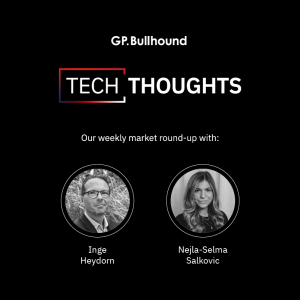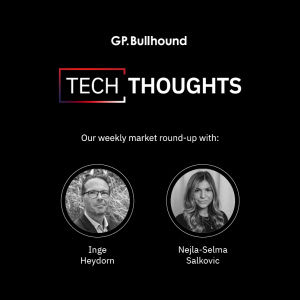Tech Thoughts Newsletter – 11 November 2022.

Our conclusions
- Semiconductor demand in general is still healthy with good October numbers from TSMC and UMC. Automotive demand continues to be especially strong.
- In semi capital equipment the structural still outweighs the cyclical for us – and ASML’s guidance upgrade spoke to that. Technology upgrades, tech sovereignty and the structural supply gap at trailing edge nodes are all driving semiconductor capex.
- We’re still seeing PC suppliers cutting back on volumes and digesting down their inventories. The Mobile handset market is more mixed for the moment although some suppliers seem to be seeing volumes stabilizing. We’re starting to ask if we’re close to the bottom?
- Gaming isn’t dead, but it is now certainly more dependent on new releases. What hurts is that mobile, which has been the strongest segment in recent years, is now the weakest, as macro starts to bite (impacted by both ad spend and in-game consumer spend).
Semicap equipment – ASML upgraded guidance shows the structural beats the cyclical
- ASML (owned) upgraded its mid and long-term guidance (well ahead of consensus) ahead of its capital markets day today – indicating that it will sell more of its high end EUV and DUV lithography machines. We think it is likely seeing demand from two big areas:
- (1) leading edge tools related to the battle for technology leadership between TSMC, Intel and Samsung
- (2) capacity for the still under-supplied trailing edge nodes – where there is structural demand driven by areas like autos and the shift to EV; and renewables. Related to the SMIC capex announcement we wonder out loud the extent to which China will look to serve this part of the market, given they can still receive trailing edge tools – this would make China strategically important in semis for a long time to come
- SMIC is boosting capex spend from $5bn to $6.6bn for this year, which means spending $2.2bn in Q4. Given all of the US semicap equipment names warned around China restrictions we ask ourselves if this might have been somewhat premature..
- Tokyo Electron reduced its guidance – related to both memory cuts and China restrictions (though as above we wonder if this might change)
- WSJ reported TSMC is going to build a 3nm fab in Arizona – again, the battle for tech sovereignty in semis will continue to be a significant driver for semi capex. There was more news this week too that Japan would allocate $3bn for advanced chip production (in collaboration with the US.. It isn’t clear yet if that comes with some agreement to comply with China export restrictions)
- Huahong Semiconductors reported a sales growth of 40% yr/yr in 3Q and with a capacity utilisation well above 100%. The company is guiding for a flat sales number qtr/qtr for 4Q. The company increased spending heavily in the quarter reaching $429m up from $112m in 2Q22. Looking at the sales breakdown the company should not be affected by the US rules and thereby given their utilisation rates, spending should continue.
Semis still strong overall
- TSMC (owned) October sales NT$210bn up 54% yr/yr and 1% mth/mth. The company now needs to have a run rate of NT$204bn during November and December to be flat qtr/qtr. We see NT$210bn as a very solid number, indicating the demand environment continues to be healthy in semis.
- UMC (TSMC’s little brother..) October sales grew 27% yr/yr but down slightly mth/mth. Again – a good enough number to indicate a still healthy environment.
- Global Foundries sales grew 22% yr/yr in 3Q driven by increases in both wafer shipments, richer mix and ASPs. The company has seen some clients cutting back some volumes but the magnitude has been limited. Automotive was noted as the brightest area of strength in demand for their business. The number of long term agreements (where clients commit to volumes) that have been signed with clients has increased during the quarter. These agreements are now worth above $27bn, and prepayments for its capacity is up 6% qtr/qtr.
- We’ve spoken about this before, but again, this makes us ask ourselves whether the risk and the returns of the semiconductor industry are shifting. Risk is being transferred away from the foundries and the semicap equipment players via non-cancellable orders, prepayments and under-utilisation charges. We really think it has the potential to change the long term returns, cyclicality (and therefore valuation) profile of many of these businesses.
China: Apple’s woes but chip restriction workarounds a positive?
- Apple put out a release over the weekend reducing its shipment expectations for its iPhone Pro models given the lockdowns in the Zhengzhou area of China.
- Foxconn separately reported later in the week, and while Q4 will be impacted by the lockdown, the message from Foxconn (if we choose to believe it) is that the situation is manageable..
- Apple and China’s inter-dependence is huge. This particular Foxconn factory is important because it’s the iPhone Pro – the most important product in Apple’s line up – the highest margin and the one which is in the highest demand, the most “brand” added. Apple has built up a significant supply chain in China – including its YMTC memory project. That China supply chain used to be amongst its biggest competitive advantages (an ability to supply complex quality products at very very high volume) – and is now starting to look like a big vulnerability…
- Nvidia has released a “China chip” which effectively slows it down to a point where it meets the US export restrictions. It’s not clear whether the US government pre-approved the move (we assume almost certainly not!) but it does perhaps give us some hope that there will be workarounds to prevent a complete US/China fall out..
No let up in the PC market… but small signs of life in handsets
- Quanta and Compal October numbers continued to fall mth/mth indicating that the inventory levels are still being reduced. Quanta shipped a total of 4.2 million notebooks in October, down about 20% on month. Compal shipped 2.9 million notebooks in October, down 6.5% on month. Still no signs of that COVID refresh cycle…
- The picture in the handset market is more mixed with weak numbers from MediaTek while both Largan and Sunny Optical reported mth/mth increases.
- Asustek Computer has scaled down substantially its motherboard and other component inventories, which will return to their appropriate levels at the end of this year, according to company co-CEO SY Hsu.
Media/Streaming/Ads
- While subscriber trends were solid, Disney (owned) quarterly results – and guidance – were weak across the board.
- Streaming is key to get momentum in Disney’s earnings back. Management reaffirmed the view that losses were peaking (we’ve heard that before… but there are some reasons to believe it, particularly with Disney’s ad tier launching).
- Disney is spending $30bn in cash content this year and next, which taking a step back is an extraordinary sum, one where we start to question the returns profile of all of the streaming businesses, even at maturity. Disney has differentiated content but it strikes us that there might be some mission creep away from that with so much commodity content (and lots of competitive bidding) in the market – and we question the long term returns picture for streaming businesses. For us it’s Sony – the one content owner we own that ISN’T running its own streaming business – that really benefits – it is seeing its Pictures content prices being bid up by all the streaming platforms…
- Unity and Applovin both reported weaker ad business in 3Q and indicated more weakness in to 4Q. Mobile gaming companies have clearly slowed down their ad spending as in-app monetisation has slowed. The feedback loop in in-game advertising for gaming companies is quick – you spot your game isn’t being monetised as well through in-app purchases and therefore your ROI on advertising that game decreases, and you spend less on ads. It’s a very clear sign macro is hurting.
Gaming – not dead but more title driven and mobile weakness driven by macro sensitivity
- US NPD data for 3Q2022 showed that overall content spending during the quarter fell 7% year-over-year to $10.64B; Hardware spending rose 16% and accessories spending fell 12%. PlayStation 5 led hardware in both unit and dollar sales terms. Consumer spending in mobile games fell 9% – reflecting the weakness we’re seeing everywhere, with mobile being much more sensitive to the macro.
- TakeTwo results were disappointing – driven by a slow-down in their mobile gaming unit. The weakness came particularly from in app game purchasing while the ad demand was up yr/yr. Our read is that the weakness was especially felt in Poker and Casino games – which we think are macro sensitive. On the console side NBA23 was in line with NBA22 which is solid. The company revised down their bookings guidance for the year on the back of the weaker mobile demand.
- Roblox sales for the quarter were already reported but the level of losses was larger than expected. The company also indicated that their cost base will continue to grow driven by investments and hiring. October bookings totalled $233m, up 5% mth/mth, below expectations of $240m.
- Nintendo (owned) reported results inline with our expectations driven by better than expected demand for Software (Splatoon3) while Switch units were 0.5m lower than expected. The company also lowered their annual forecast for Switch sales from 21m to 19m, as the company is still struggling with supply. Our models indicated better volumes for Switch – we look at sell through data which was almost flat yr/yr while sell-in – which is what Nintendo reports was down 15% yr/yr. There are two possible reads here: (1) sellers of Switch are less optimistic on future sales; or (2) Nintendo has been unable to deliver supply. We think the latter – and that supply issues will be resolved – and so continue to be positive towards the shares.
Our portfolio
We have increased our positions in TSMC, Alphabet and Cisco this week while we trimmed our position in Disney.
For weekly insights on the latest market updates, please subscribe to our Tech Thoughts podcast.
For more information about Tech Thoughts, please visit https://www.gpbullhound.com/tech-thoughts/.
We provide investors with access to category leading technology companies, globally. Our assets under management have a total value of more than €1bn, and our limited partners include institutions, family offices and entrepreneurs. Learn more about our funds here.
Enquiries
For enquiries, please contact GP Bullhound’s Public Funds team at public.funds@gpbullhound.com.
About GP Bullhound
GP Bullhound is a leading technology advisory and investment firm, providing transaction advice and capital to the world’s best entrepreneurs and founders. Founded in 1999 in London and Menlo Park, the firm today has 12 offices spanning Europe, the US and Asia. For more information, please visit www.gpbullhound.com.

